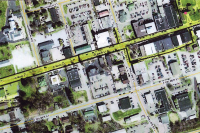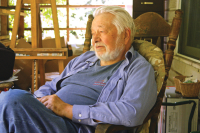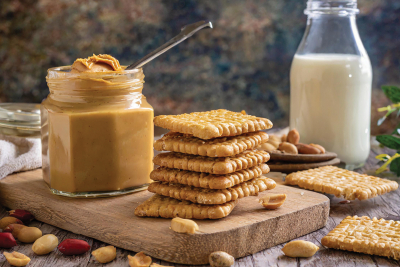Shagbark hickory among the most interesting in WNC
 The walnut family is relatively small, but it contains some of the more interesting and valuable tree species found in Western North Carolina. In WNC there are only two genera, the walnuts (Juglans) and the hickories (Carya).
The walnut family is relatively small, but it contains some of the more interesting and valuable tree species found in Western North Carolina. In WNC there are only two genera, the walnuts (Juglans) and the hickories (Carya).
Ash trees, which belong to the olive family, have leaves that are divided into leaflets in a fashion similar to those in the walnut family. Note, however, that ash leaves are arranged opposite to one another, while walnut and hickory leaves alternate on the branches.
The two walnut species in WNC are black walnut (J. nigra) and butternut or white walnut (J. cinera). Black walnut provides some of the finest cabinet wood and their nuts are utilized by wildlife and humans. Butternut wood is not as valuable as black walnut since it is less strong and durable. The nut kernels, however, are quite sweet and much easier to get at than those concealed within the harder-than-brick shells of black walnut.
Hickory trees are, of course, renowned for their use as firewood, for making tools and implements, and to cure hams, sides of bacon, and other meats. There are five hickory species in our region: bitternut (C. cordiformis), pignut (C. glabra, which includes two variant forms), mockernut (C. tomentosa), sand (C. pallida), and shagbark (C. ovata).
The first three species are by far the most common, occurring in bottomlands and dry woods in virtually every mountain county. Telling them apart, however, can be tricky.
Related Items
The most exciting hickory species to encounter, for me, is the shagbark. It’s aptly named for the unmistakable smoke-gray bark, which peels off the tree in long, vertical strips (6 to 8 inches in width) that are often unattached at either end. Be careful.It is easy to misidentify several variant forms of other hickory species that are “somewhat shaggy” as shagbark hickory.
In A Natural History of Trees of Eastern and Central America (Houghton Mifflin Co., 1950), Donald Culross Peattie observes that for “everyone with a feeling for things American, and for American history, the shagbark seems like a symbol of the pioneer age, with its hard sinewy limbs and rude, shaggy coat, like the pioneer himself in fringed deerskin hunting shirt.”
The early North Carolina explorer and observer John Lawson called it “flying bark’d hiccory,” and the tree does resemble an unkempt bird about to take flight.
George Ellison wrote the biographical introductions for the reissues of two Appalachian classics: Horace Kephart’s Our Southern Highlanders and James Mooney’s History, Myths, and Sacred Formulas of the Cherokees. In June 2005, a selection of his Back Then columns was published by The History Press in Charleston as Mountain Passages: Natural and Cultural History of Western North Carolina and the Great Smoky Mountains. Readers can contact him at P.O. Box 1262, Bryson City, N.C., 28713, or at This email address is being protected from spambots. You need JavaScript enabled to view it..













